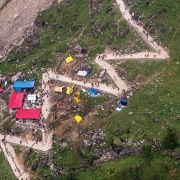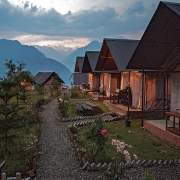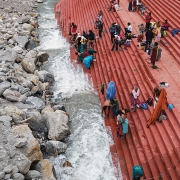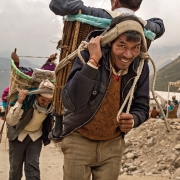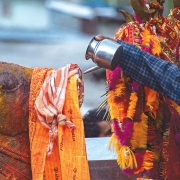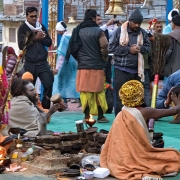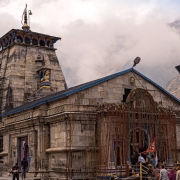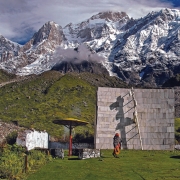
Etcetera
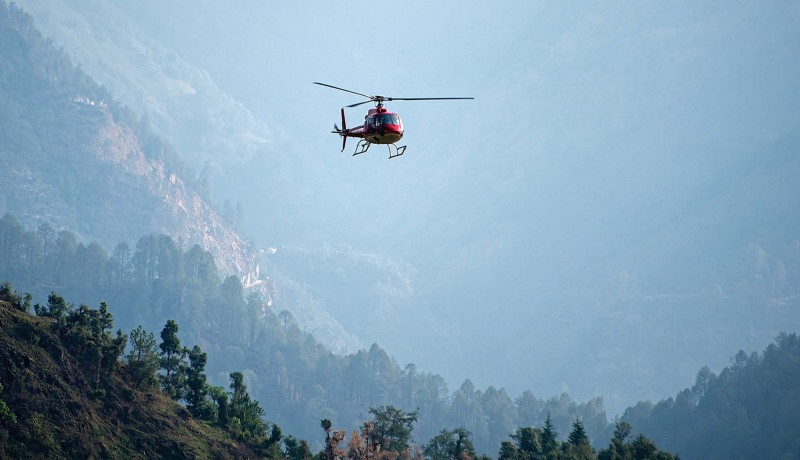
Helicopter rides make travelling to Kedarnath, the highest jyotirlinga, a breeze.
As our six-seat chopper lifted off in a flurry of dust and noise, blades whirring, we felt like air-borne demigods. Leisure Hotel’s Char Dham Camp at Guptakashi, Uttarakhand, located amid flower-spangled landscaping, was swallowed in the mist as our chopper skimmed over snarling ravines and gorges.
The flight was more scenic than white-knuckled—and why would we be afraid when our mission was spiritual? We were flying to Kedarnath, the abode of Lord Shiva in the Garhwal Himalayas, one of the Char Dhams, sacred to Hindus and the highest of the 12 jyotirlinga located in India. The chopper flew like a nimble gnat over the romping Mandakini river, swooping over mountain folds and the 15-km walking path where weary pilgrims trudged like tiny ants that never sleep.
The chopper soared into innocent blue skies with marshmallow clouds. Eight minutes later we landed at a small helipad (3,581 m), hewn in the midst of mountains that seemed to frown at our intrusion. Our pilot, Colonel Rajgopalan, an ex-Army man, told us the weather would in all likelihood pack up soon and advised us to rush for our darshan and be back in an hour. Normally, pilgrims get two hours at Kedarnath if they arrive by helicopter.
The mountains rose in a radiant rampart ahead of us as we walked to the petite grey stone 8th century temple, which presided proudly over the pilgrim town, its entrance festooned with garlands. From there a queue of pilgrims, waiting for darshan of Lord Shiva, snaked away into the distance. The pilgrim town is essentially a conglomeration of buildings—some a pile of rubble, after the disaster of 2013—wedged in a green valley. This is not a place to tarry, should the mountain titan decide to crack his knuckles, though tourist-friendly facilities have now been created.
A paved path led to the temple via the makeshift offices of helicopter companies, tented accommodation for pilgrims, sparse dormitories for silvers, dhabas, restaurants and via the ghats on the Mandakini river where pilgrims take a purifying dip. We walked shoulder to shoulder with weary devotees—some bent and elderly—with staves who had trudged up 15 km from Gaurikund, feeling faintly guilty about our short comfortable flight.
Most of them were beaming, even though many told us that it took them six to 18 hours to climb up with short rests along the roadside. Some even took halts to sleep in the open to rest their tired limbs. But nothing deterred them for they were buoyed by boundless devotion to the divine. Frail men in dhotis and women in flimsy saris and chappals were borne along in basket chairs, strapped on the backs of sturdy Nepalis, some as young as 16.
We were part of a pan-Indian army of spiritual souls, resonating with a melee of accents and languages, ranging from Hindi, Tamil, Telugu, Malayalam and Marathi, to city slickers who had flown in and spoke impeccable English. Some had come with elderly parents in tow, who in keeping with tradition were fasting prior to getting a darshan. There was a sprinkling of young trekkers, and extended families on the ultimate yatra, best done before you turn 70.
All were bound by collective faith that could literally move mountains and seemed to vibrate across the bare bones of the earth as they chanted, “Om Namah Shiva,” with a thumping regularity. The chant seeped into our skin and cells. Those were goosebump-moments as we saw pilgrims being blessed by ash-smeared sadhus in flaming orange robes, waving peacock feathers; other less dramatic but equally imposing holy men conducted puja outside the temple, their faces blurred by scented smoke, giving the ritual a timeless feel.
The queue moved towards the temple entrance quietly and with infinite patience that sprang from a faith so boundless and deep, the likes of which we had never seen before. It rippled softly like a river through the crowd, faces aglow with an inner light that announced that all were on a common mission: to seek reprieve from suffering and aspiring for moksha, a release from the endless cycle of births and rebirths.
“It is this spirituality that holds the country together and keeps us going,” said a devotee from Mumbai, almost moved to tears by the teeming multitudes who had braved hardships to come to the ultimate dham. In contrast, he and his family had arrived by helicopter and were staying in comfort at Leisure Hotel’s Char Dham Camp at Guptakashi. Yes, pilgrimages are great levellers, erasing all divisions of caste, creed and even religion.
We were mute spectators to this ancient cameo of a throbbing spirituality that we could not entirely identify with but could only dimly understand. No one questioned our camera-festooned presence as we moved amidst the crowd, taking it all in and storing it in our memory bank and in digital images. People smiled indulgently; this was a live-and-let-live gathering of the pious, intent on connecting with their God and happy to share His beneficence with everyone there.
The occasional tout wanted to take us away to god-knows-where but took our brush-off with a sporting smile. A standard opener of itinerant priests wanting to sell their services was: “Aap kahan se aaye ho (Which part of the country have you come from)?” They smiled benevolently at our Westernised urban look, strangely out of sync in this other-worldly gathering of simple folk who were carrying their possessions in neat little bundles.
The VIP darshan (for a price) allowed us to enter the hallowed precincts from a side entrance and pay homage to the lingam enshrined in the inner sanctum of the shrine, said to have been built by Adi Shankaracharya in the 8th century. The current temple stands next to the mythical temple believed to have been built by the Pandavas to atone for the sin of killing their brethren in the war in Kurukshetra, as narrated in the Mahabarata. The Pandavas sought out Lord Shiva to obtain his blessings and forgiveness but the Lord gave them the runaround and finally took refuge at Kedarnath in the form of the Nandi bull.
In the courtyard and near the temple door stands a huge statue of the Nandi bull. Some pilgrims prostrated themselves in the courtyard before moving into the assembly hall, richly decorated with figures of various deities and scenes from Hindu mythology. As they made their exit, they stopped by a huge boulder to pay their obeisance, for it is now part of folklore that it was this boulder that prevented the torrential waters of the melting glacial lake from destroying the temple in the 2013 disaster.
We walked back to the helipad only to discover that mist and clouds had rolled in on gossamer wings and obliterated the flight path of the choppers. Thunder rumbled above and seemed to echo in the barrel-chested mountains. We would have to spend the night in Kedarnath and managed to get two beds in a dormitory for silvers with en-suite facilities that we shared with a burly man from Bihar and another from Punjab. But the camaraderie that binds all those who embark on a spiritual quest helped mute any twinges of discomfort that the four of us might have felt on being thrown together at short notice.
As people gathered for the evening aarti, everything was shrouded in a surreal atmosphere. The astringent Himalayan air, thick with devotion, knifed us, yet we revelled in it. People gathered once again at the glowing shrine, swaying and chanting even as temple bells pealed and drums pounded in a stirring almost primeval ritual. For this service, the deity is festooned in flowers and gold ornaments and a gold umbrella suspended over its head. The lamp-lit sanctum was not visible because of the rush of people outside it. But the air was heady with the fragrance of incense, the chanting of Sanskrit shlokas and Vedic prayers while the snow-clad peaks that framed this moving spectacle seemed to smile down enigmatically. Little wonder then, that in the Indian tradition, the Himalayas are said to be devatma (with the soul of God). The petite Kedarnath temple stood timeless and inviolate even as the moon’s beams seemed to gild the ancient stone.
The next morning the skies were clear and our chopper lifted off again into the rarefied air. We pondered on how pilgrimages had become easier—we had not huffed and puffed up to stratospheric heights nor bumped upward on a pony or in a palanquin. But we had got our darshan—we had viewed Kedarnath temple; seen God in the faces of the multitudes who go there to seek Him; felt his presence in the unpolluted air as pure and heady as the waters of the Mandakini that would join the Alaknanda at Rudraprayag to ultimately become Ma Ganga, the mother of all rivers.
We could not have asked for more!
FACTFILE
Kedarnath is the third leg of the holy Char Dham yatra in Uttarakhand. The other stages of this pilgrim trail, considered to be the most sacred by Hindus, are Yamunotri, the source of river Yamuna; Gangotri, the source of river Ganga; and Badrinath, the abode of Lord Vishnu. One may even undertake one or two dham yatras.
WHEN TO GO: The Kedarnath shrine is closed in the winter months and is open generally from mid-May to November. The dates are decided by the priests in the temple at Ukhimath where the idol rests and is worshipped in the winter months. But the best months to travel are May, June, September and October. July and August see a lot of rain and landslides.
GETTING THERE
By air: The nearest airport is in Dehradun, from where buses and taxis are available to travel to Guptkashi.
By rail: Rishikesh and Haridwar are the nearest railway stations.
TIPS: Make Guptkashi your base and travel to Gaurikund from where ponies, palki and pittu (porters) are available. Silvers may avail of choppers as several companies operate from Guptkashi, Phata and Agusthyamuni. Carry a jacket and raincoat or an umbrella to Kedarnath as the weather can be unpredictable. Registrations are mandatory for pilgrims travelling to Kedarnath as are health checkups for those over 50. Registration and health checkup counters have been set up at Guptkashi, Sonprayag and Phata. According to the Uttarakhand Tourism website, if you have not done so, facilities are also available at Kedarnath.
For more information, visit the official website of Garhwal Mandall Vikas Nigam, www.gmvnl.com and Leisure Hotels, www.leisurehotels.co.in
Text & Photographs by Gustasp and Jeroo Irani Featured in Harmony — Celebrate Age Magazine September 2016
you may also like to read
-
Cracking the longevity code
Small yet impactful choices can be game-changers, writes Srirekha Pillai At 102, there’s no stopping Chandigarh-based Man Kaur, the world’s….
-
Home, not alone
While a regulatory framework is vital for senior-care facilities, the need of the hour is to develop an ecosystem to….
-
Birthday Girl
Published in a special edition to honour Japanese master storyteller Haruki Murakami’s 70th birthday, Birthday Girl (Penguin; Rs 100; 42….
-
A huge treat for music lovers
Published as the revised and updated second edition, Incomparable Sachin Dev Burman (Blue Pencil; Rs. 599; 470 pages) the authoritative….



